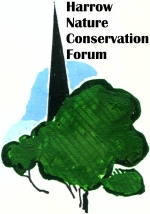
Newton Farm Ecology Park

Newton Farm Ecology Park is a small area of wood and grassland lying between Alexandra Avenue and Raynerís Lane in the south of the borough. Although small it contains a wide variety of habitats including wet and dry grassy meadows, woodland, streams and a pond. The wooded areas contain many varieties of apple as well as ash, birch, cherry, dogwood, field maple, hawthorn, hornbeam, oak, black and white poplars and rowan.
Within the wood is a small area originally planted as a healing garden with plants that in earlier times were believed to have healing properties. The healing garden was recently restored with a grant from Greggs the bakers.

Birds foot trefoil in the Healing Garden

In 2018 an area of bramble in the southeast corner of the site was cleared to form the "New Meadow" and sown with wildflower seeds. This looks spectacular in spring and early summer - image above.
Things to look out for:

